Editor’s note: This is one in a series of articles looking back on the department’s
first 25 years—remembering the people, issues and cultural forces that have
shaped the agency and the milestones Mn/DOT has achieved.
 |
|
Oil shortages drove
bikeway development in the 1970s. Even today, as this biker's T-shirt
suggests, many bicyclists cite gasoline costs and environmental concerns
as reasons for biking. Photo by Kevin Walker
|
The oil shortage of the 1970s made mostly temporary changes in Americans’ lifestyle
choices, economists claim. Minnesotans, however, have at least one long-lasting
change from that era that’s embedded in the soil itself: a comprehensive statewide
bikeway system begun in that decade.
Bicycle transportation was part of Mn/DOT’s charge from the very beginning.
State legislation in 1976 and 1977 authorized planning for and construction
of bikeways, along with developing bike maps to help residents find and use
bikeways effectively.
This same legislation also brought Nancy (Mahle) Melvin from the Department
of Natural Resources to lead Mn/DOT ’s new bicycle transportation unit from
1977 to 1985.
Creating the bikeway system
"When I came to Mn/DOT," Melvin said, "I had a photocopy of
the legislation, a phone book, and a phone, and I was told to set up a ‘bike
program.’ So I began knocking on doors, making calls and learning this complex
organization."
The Legislature had directed Mn/DOT to do what staff referred to as "the
three C’s: coordinating, constructing and communicating information statewide
on bicycle transportation."
"The bicycle transportation construction program was aggressive,"
Melvin said. "We had our hands full. We were obligated by state law to
do needs analysis, mapping and construction of bicycle trails and road improvements.
We needed to develop a process to integrate non-motorized transportation into
our planning and development work."
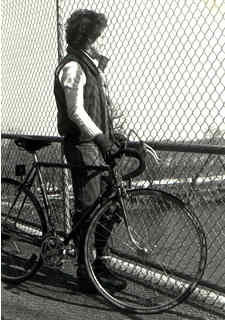 |
|
This type of separate
fenced-off bikeway that parallels the highway can also accommodate bicyclists
on freeway routes. Here, Nancy Melvin, Mn/DOT's first bike unit chief,
takes in the view from the Cedar Avenue Bridge over the Minnesota River
in 1982. Photo by Donnie Carr
|
Laying a solid foundation
The key to the success of this program, she said, was cost-sharing and local
involvement.
"We had frequent contacts with districts, cities and counties to manage
a grants-in-aid matching program," Melvin said. "This enabled cost-sharing
of construction projects and stretched the funds to accomplish the priority
needs. Two examples are the bike-pedestrian accommodation on the Cedar Avenue
Bridge at the Minnesota River and the I-494 Bridge from Bloomington to Eagan."
These days, Melvin works as transportation planning director for Metro Division’s
Office of Planning and Investment Management. It’s been 16 years since she last
served as chief of the bicycle unit, but Melvin can still quickly reel off a
list of her section’s accomplishments.
"We constructed 1,200 miles of bikeways and road enhancements costing
$12 million," she said. "We mapped the entire state. We developed
formulas to evaluate roads for bicycle use and suitability. We developed a standards
manual for designing bikeway facilities. We printed detailed bikeway maps. We
had a speaker’s bureau, promoted safety, and talked with bicyclists, city planners
and engineers to learn about gaps and opportunities."
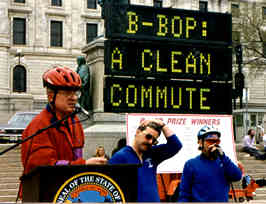 |
|
Bob Works, Sustainable
Transportation Initiatives director, practices what he preaches when he
bikes to his St. Paul office from his Bloomington home. Here, he congratulates
B-BOPers while selling the "bicycle message." Photo by Kevin Walker
|
Bikeway planning today: different driving forces
It’s been many years since we’ve had a long-term oil shortage, but two prominent
issues today could revive public interest in bikeways, according to Bob Works,
director of the Sustainable Transportation Initiatives section, Office of Environmental
Services. STI promotes walking, telecommuting and bicycling.
Works participates every year in the Bike, Bus or Pool (B-BOP) spring event
and believes that "the national obsession with fitness can be a driver
for bicycling." He also cited mental and emotional benefits "from
biking or walking to work. When I bike to work, I have a whole different outlook
on my day."
The other issue—traffic congestion—has become the public’s biggest transportation
concern today. Works sees interest growing in bicycling’s potential to help
reduce traffic.
"From the federal level, there’s substantial support from the Federal
Highway Administration to increase the percentage of people using modes other
than cars for commuting," Works said. "We need to work with local
governments to help people see how to create bicycle network systems in their
communities. Too often they have mainly a bike trail or two, but not a system."
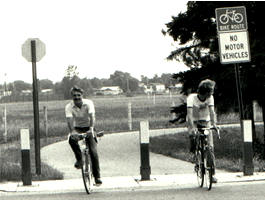 |
|
These 1985 bicyclists
enjoy the most popular of the three types of bike enhancements: separate
bicycle paths that occasionally intersect with roads.
|
Surveys suggest public interest
Recent surveys suggest that public interest in bicycling as an alternative
means of transportation may be rising. Respondents to the 2000 FHWA nationwide
survey placed biking high on their list of perceived alternatives to driving.
"We’re paying a lot of attention to what our customers say via market
research surveys," Works said. "There’s an untapped market out there
of people who’d bike to a bus facility that has a secure place to store bikes."
According to the FHWA’s survey, respondents indicated the following:
-
70 percent said that expanding existing public transportation would better
serve their communities.
-
69 percent suggested building new bikeways and sidewalks.
-
68 percent wanted better quality traffic information.
-
64 percent advocated expanding existing highways.
A second study, the University of Minnesota’s 1999 Statewide Tracking Study,
yielded these findings:
-
18 percent of working Minnesotans said they live close enough to their
workplace that they would consider bicycling to work.
-
4 percent already bicycle to work at least a few days a year.
-
About 25 percent of the population bicycles to other destinations as an
alternative to driving.
-
An additional one-third said they would consider doing so.
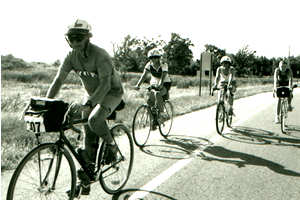 |
|
An alternative bike
enhancement-paved six-foot-plus shoulders-accommodates these 1985 bicyclists.
The bicyclist on the highway is there legally; bicycles are a legal road
vehicle unless otherwise prohibited.
|
Biking directions
"A lot of good things have been built and advocated in the last 25 years,
and we want to continue in that vein," said Darryl Anderson, state bicycle
coordinator. "We really want to build upon the past as we strike out into
the future."
Today’s limited funding, however, requires a more targeted approach, Anderson
said.
"We want to maximize our limited resources and provide the right tools
in the right places to provide the best possible guidance for designers,"
he said.
Recent efforts and current plans include:
-
Publishing the 2001 Twin Cities Metro area system plan;
-
Updating Mn/DOT’s design standards manual and statewide system plan;
-
Sponsoring bike facilities design training sessions around the state;
-
Printing new bike maps;
-
Working with Mn/DOT planners in district offices and Central Office to
design highways that bicyclists can use safely; and
-
Looking at how bikeways, pedestrian facilities and telecommuting fit into
Mn/DOT’s 2003 transportation plan (in draft stage).
A Jan. 1999 technical memorandum clearly spells out Mn/DOT’s current direction
on bicycles:
"When developing a trunk highway improvement project, Mn/DOT will determine
what is necessary to safely accommodate bicycles in that section of roadway."
-Technical Memorandum #99-04-#S-01, 1/19/99
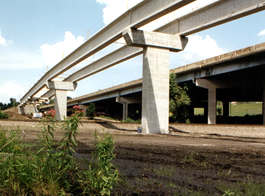 |
|
Minnesota has the first
"bicycle freeway" in the nation: the Cedar-Lake Bicycle Path, which extends
about four miles from Hwy 100 to downtown Minneapolis, paralleling I-394.
|
Planning new trails
Anderson and Works said they have seen "a real willingness by planners
to work with bicycle checklists and design plans." This is evident in transportation
plans coming from the office of Mn/DOT’s former bicycle unit chief.
Melvin, who today works with Metro Division’s portion of the transportation
system plan and "Moving Minnesota" (advantages for transit, bottleneck
removal, integrated regional corridor development), said she still watches out
for bikeway opportunities in her section’s transportation planning.
"Bicycle transportation is an important element of modal planning,"
she explained. "We incorporate bikeways in our planning products when we
plan for highway construction. We need to keep a systems perspective and work
together to make the network operate better. Having bikeways as one component
of our planning makes good business sense."
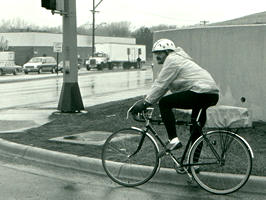 |
|
Jim Nelson, Metro Division
transportation planner, bicycles to work in all kinds of weather, as this
1991 photograph shows. Photo by Kent Barnard
|
Anderson believes that the timing is right for shifting bicycle transportation
into high gear.
"We really have an opportunity with this administration," he said.
"They’re very interested in a multimodal and holistic approach to transportation.
We want to really ‘step up to the plate’ as best we can to provide realistic
pedestrian, bicycle and telework options."
Commissioner Elwyn Tinklenberg added, "This administration’s commitment
to multimodal transportation means providing transportation choices for Minnesota.
Bicycling is an important part of that—not an afterthought, not a sideline activity,
but a full partner."
|
Mn/DOT marks its
25th anniversary on Nov. 8
On Thursday, Nov. 8, Mn/DOT marks the 25th anniversary of the day the
department was officially designated by the Legislature. The agency
was formed on Nov. 8, 1976, to encompass all major transportation modes
in one department.
Related legislation authorized Mn/DOT to create a bikeway system and
develop maps showing suitable biking routes (see above article).
|
:
|


